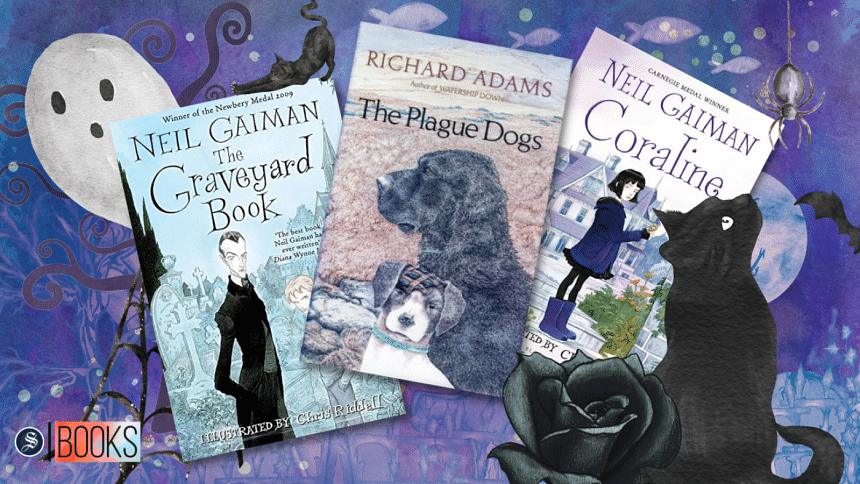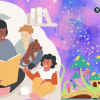On the many flavours of horror in children’s literature

It's not groundbreaking to claim that children's literature is chock full of imaginative, yet very often very macabre, elements. "Who let Coraline be deemed children's literature?" is, unsurprisingly, a very common sentiment shared among my friends and online. Neil Gaiman seems to think that writing stories for children requires careful choice of words—what you present and, perhaps more importantly, how you present something, go to great lengths to impact the mind of someone in their formative years. So why is it that both Coraline (Bloomsbury Publishing. 2002) and The Graveyard Book (HarperCollins, 2008) are stories presented with an undertone of horror? What do we make of the mysterious thread that connects these stories not by genre, but by an imagination so wondrous they leave room for an underlying horror, and the many things that can mean?
Horror isn't easy to define, horror isn't even easy to understand. Horror, so often, comes from unknown threats and the creeping realisation that the world is much bigger than our protagonist had assumed. It's a trope in storytelling, but it's one that works particularly well when combined with the kind of whimsy only found in a children's story—these elements clash like opposing forces and eventually find a way to merge, leading to the birth of stories steeped in an imagination that is deep and vast, but finds a way to come back to the world we, as people, inhabit. After all, no part of A Monster Calls (Walker Books, 2011) by Patrick Ness or The Plague Dogs (Knopf, 2016) by Richard Adams was written to be cut off from reality, if anything the topics explored in these stories are heavy—almost too heavy for a child to process.
And yet these books are frequently described as 'children's literature', not because of their whimsy, but because of the imaginative nature in which death, animal abuse, and the spread of hateful propaganda are explored. They are not mere tools that play into the story, but concepts that are introduced to the reader in a way to nudge them to understand—if the world and its workings are not kind, then the story has to let them know, but kindly. To me, the main difference lies here: kindness and imagination are the barriers between adult and children's fiction. Even if they are outright—or innately—horrific to read, that quality makes itself at home in these books.
I see this unexpected marriage between kindness and horror in so much of what I read. Part of it, obviously, comes from an understanding of the world around me. I have come back around in recent years to read more literature meant for children only to return to the realisation that these stories weren't always carefree. Whimsical, perhaps, but so many of these stories offered more than just that. I read Sitti's Secrets (Simon & Schuster, 1994) by Naomi Shihab Nye (illustrated by Nancy Carpenter) recently, out of frustration and a desire to discover more Palestinian literature. Even in this story, where so little is presented, there is a horror that permeates, you can't very easily put your finger on it—because it's not the horror that we're used to. It's not a story of monsters gothic and creepy trying to trap little children—but the air seems to smell different here. I think horror as a term is extremely vague, but the horror that comes from the news you see every day can feel just as palpable when it is found in the sorrow that underscores a simple story about the love shared by a grandmother and her granddaughter across thousands of kilometres. And I don't think children fail to pick up on it either; while the nature of their response to the didacticism of a story depends on many things, I do think most children are far more understanding than many may assume.
The flip side to this is perhaps in how horror exists as something more explicit in children's stories. As a child, I would voraciously go through every single Goosebumps entry available in my school's library. For Ekushey Boi Mela, the books I'd nag for would be collections of Bangla ghost stories. None of these would necessarily stick with me as I grew up—but what keeps this memory alive inside of me is the desire that lingers somewhere in the back of my head to look at a mundane scene as something beyond the ordinary. A teacher turning into a cannibal, a train coming to life, fever dreams turned to words that burned an image in my head over a decade ago that still, somehow, affect me. For the better, that is. The impact of a story, especially when read at ages when the brain is at its most elastic, stretches into deep corners of our minds. Horror, to me, is the most versatile way a story can be told because horror lies in nearly everything. It is an elastic creature ready to take on a hundred different shapes and leave a hundred different impressions. There is no doubt children would connect to these stories—after all, horror is fundamentally child-like.
Raian Abedin is a poet, a student of Biochemistry, and a contributor for The Daily Star.

 For all latest news, follow The Daily Star's Google News channel.
For all latest news, follow The Daily Star's Google News channel. 








Comments